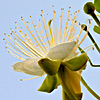Capparis sinaica is an evergreen thorny shrub, with thick woody branches. Cruel, hooked thorns are found at the base of each leaf. The shrub is branched, dense, and reaches a height of 1-2 m. It often dangles from a rock. The leaves are cartilaginous, and are carried on long petioles. They are round, large and thick, glabrous, with an entire margin. A short hooked thorn extends from their tip, from the end of the midvein.
Capparis sinaica blooms between February and April. The flower is large, with a diameter of 5 cm. The pedicel is long. Bilateral, and not radial, symmetry is prominent already in the bud, and even more in the open flower. The flower blossoms for only one night, and closes by midday of the following day. The sepals secrete sugary solutions on their external side, which serve as food for ants. These may protect the plant against other insects. There are numerous white stamens. The flower is pollinated by moths (Sphingidae). After pollination the ovary at the center of the flower develops into a juicy, pear-shaped elongated fruit with a length of 5 cm, and it dangles on a long fruit stalk. It is red on the outside, pink and sweet on the inside. The seeds are dark, and are dispersed by birds which are attracted to the sweet pulp.
Capparis sinaica grows in an especially dry desert, mainly in river beds and in cracks in rocks. In Israel it is common only in the very south – in the southern Negev and the Arava Valley and on the Eilat Mountains. Its global distribution spreads mainly over east Africa.
Flower buds, young fruits, young branches and leaves of different species of caper are pickled and are regarded as excellent seasoning. Capparis sinaica is more pungent for this purpose than others of its genus. A branch from which all organs except for one hooked thorn were removed was used for "fishing" leeches out of the throat.
The genus contains 350 species. Four species grow in Israel. The leaves are simple and entire, with hooked thorns at their base. The flower is large, with bilateral symmetry. One of the 4 sepals is larger than the others and concave. There are 4 petals, of which 2 are adjacent to this large sepal. They are attached to each other and create a reservoir for the nectar. There are numerous, long, colorful and prominent stamens. The ovary is carried on a long pedicel (gynophore), which is considered to be a primitive trait. The fruit splits longitudinally (some say that this is the origin for the Hebrew name, from split - mefazel) and its peel rolls backwards.
Written by Mike Livne






